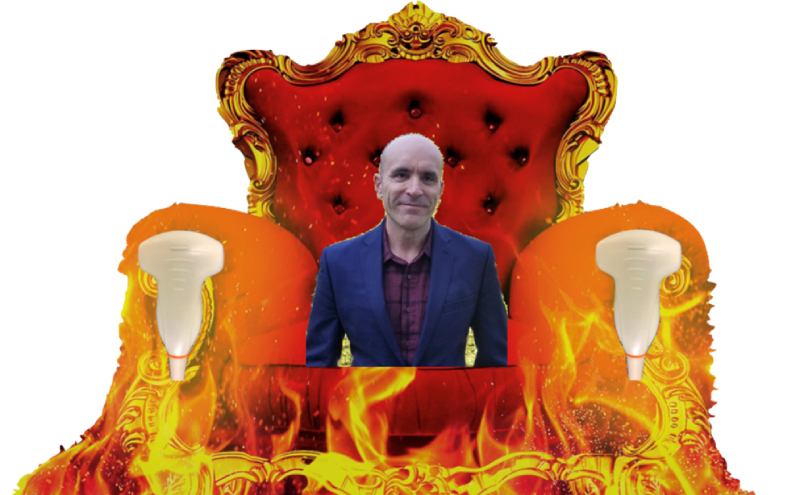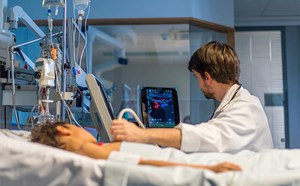
Sono Hot Seat with Michael Blaivas: On Clinical Innovation and Artificial Intelligence in POCUS
Michael Blaivas, MD, MBA, FACEP, University of South Carolina School of Medicine
Questions posed by Stephen Alerhand, MD
Q: For a variety of POCUS applications, the research and literature all seemingly started off with a case series by Michael Blaivas.
A: I actually published few case reports or case series mostly focusing on prospective and larger retrospective studies. Cases and case series were typically for really fun things like the first ever trans-oral retropharyngeal abscess drainage or the first routine TEE usage in ED arrest resuscitation.
Q: From where did you get the ideas and initiative to try out these applications new to the emergency department?
A: Most of the studies I ran were simply questions that arose during clinical practice such as how accurately could a bunch of EPs detect proximal lower extremity DVT and before long we had a single blinded prospective study on DVT in 2000. Some were more bench type studies like evaluating the changing appearance of different wooden foreign body types in soft tissue over time, a question that arose during a patient’s care.
Q: Did you adapt them from what other disciplines were doing and apply to the emergency medicine environment?
A: Some were adaptations from other disciplines, but many came from exploring use due to needs in clinical practice.
Q: Were these applications that arose because of need encountered on shift?
A: I realized early in my training that the physical examination was a sham, at least in my hands. I recall in residency these great names in EM would palpate an ovary during a bimanual exam and tell me it was normal, I had no clue either way after my exam and simply nodded. Then I would perform and endovaginal ultrasound and see an abscess, mass or huge cyst. Similar things occurred repeatedly and drove me to adapt ultrasound to more and more of my practice. When I was too scared to blindly stick a potential peritonsillar abscess during a shift, I decided to try an endovaginal probe in the patient’s mouth to see if there was any sign of an abscess. I was shocked at how well I could see the anatomy and then guided a needle right into the abscess. Ocular ultrasound was the result of wanting to get past the barrier of limited equipment in our ED for evaluating ocular pathology. I tried scanning my own eye – amazed at what I could see, then went back to the patient’s room with a clean probe and found a small retinal detachment.
Q: Did you receive any push-back or obstacles from your department or other hospital services?
A: Push-back was pretty constant and came from different sources and departments. When I first started, many leaders in EM were against ultrasound because it was a threat to their interests, which often had much less clinical relevance and impact. Push-back from other departments differed from facility to facility. One of the oddest situations was in about 2005 when I got training in ultrasound guided regional anesthesia and started a randomized prospective trial of axillary block versus conscious sedation for shoulder dislocation reduction. It was going great and one day I had a poly-trauma patient with a left shoulder injury and elbow fracture with dislocation. Trauma didn’t want to sedate the patient but Ortho wanted to do a reduction immediately with some kind of pain control. They had heard about my blocks and convinced me to do one, despite my reluctance and typically poor coverage of the medial elbow. The elbow was so unstable the reduction would not hold and Ortho took him to the OR where Anesthesiology tried to do an axillary block but failed. They did not use ultrasound and their nerve stimulator would not work because of my block. This created tremendous controversy and embarrassment because we used ultrasound for guidance and they did not.
Q: What words of wisdom would you impart to a current ultrasound fellow or junior faculty member looking to expand the potential use of POCUS in the emergency medicine environment?
A: Know the literature in POCUS in this country and outside and not just in EM. Is there something that is being done in the ICU or in another country that could benefit your patients? Also, make use of the natural resources you have. So what if the latest buzz is about a sepsis ultrasound protocol. If you don’t have many septic patients, focus on what you have a lot of.
Q: What experiences or realizations led you to pursue a degree (or training program) in artificial intelligence?
A: I was doing my MBA at Georgia Tech in 2015 and 2016 which was very heavily technology focused. One of the classes was about big data and machine learning and its potential power caught my imagination. I started digging into relevant imaging literature reading almost everything I could find, even several machine learning textbooks. However, I still could not explain how AI for imaging actually worked. The only thing I could think of was to dive into courses and learn the coding, the architecture and do actual projects that forced me to build and train imaging AI algorithms.
Q: Was the goal always to apply it to POCUS, or did/do you have other applications in mind?
A: POCUS was a natural outlet for the AI interest, but I also did some work with wearable sensors, PPG tracings, visual diagnoses and other data. However, the first couple of projects we published with POCUS generated such interest from colleagues all over the world, that before I knew it we were involved in a multitude of AI POCUS projects. As my understanding of what machine learning could do in POCUS expanded so did my questions and interest in exploring limitations and pitfalls, hence several manuscripts exploring seldom asked questions that prove to be critical in algorithm design and implementation.
Q: What have been some challenges or surprises with implementation of AI into POCUS and industry?
A: The biggest challenge was also the biggest surprise for me. I have been shocked at how difficult it is for companies to appropriately design, create and implement an AI application. The main challenge is the translation across all of the steps and company silos from idea conception, to algorithm choice, obtaining data, algorithm training and optimization, testing, customer facing software implementation and then actual clinical use. It turns out that the AI folks had no clue about the idiosyncrasies of clinicians and clinical practice. The marketing crew just wanted cool stuff to talk about and sell without realizing what might work and how difficult it was to actually implement some ideas. AI scientists were often well equipped to create algorithms that worked in vitro, but flopped in vivo. Having created algorithms from the ground up, I seemed to be able to translate all the way across that spectrum and ruined many bad ideas for algorithms at one point or another, based on practical recognition of what would just not work in clinical settings.
Q: How do you envision AI being used for POCUS within 5 years? 10 years?
A: I think in 5 years we will only see some incremental expansion over what we have now. There will be more guidance software that will allow core POCUS exams to be performed by complete novices to ultrasound. At the same time, there will be some more pathology detection capability. Around the 10 year point is where we will see more robust, A to Z type packages. These will include protocol AI applications that will guide complete novices through an examination and collect all of the images and data for analyses, such as the original RUSH protocol and others. Vendors will create many interventional procedure guidance packages that will provide anatomy identification through needle/device insertion guidance and even success evaluation. We will also see more automated analysis, with some of it running in the background while the novice scans. For the expert user, automation will be more in line with workflow or task improvements for increased precision, speed and ease of use. There will be more complex single task AI features such as auto cardiac output calculation, strain evaluation etc. However, most of the focus will be on AI that will allow market expansion into new/untrained users of all types.
Q: Did you always envision transitioning into industry?
A: No, in fact I was trained in a purist academic, old school approach. Professors essentially told us that industry was bad, never created anything and just stole ideas from academia. It took quite a few years to realize this was complete nonsense and it was academia which was useless for bringing to market any innovations that patients might benefit from. In fact, academia was so bad at bringing things to market that we started to see establishment of technology translation centers, innovation hubs, incubators and similar centers at major institutions. In time I became open to helping industry develop products. While industry is great a bringing things to market, they have significant challenges understanding what clinicians need and how conceptualized products might fit into the clinical milieu.
Q: What obstacles were present?
A: I simply did not know how to approach industry or even how to work with them. This knowledge came slowly through experience and lots of trail and mostly error.
Q: What facilitated this?
A: The first was the research I was publishing. I have had dozens of companies approach me after presentations and ask me to help them with projects or ideas. One of the coolest was during a long day of giving abstract presentations at an ACEP in Seattle. A well-known device company’s chief engineer came to listen to one of my abstracts and then asked me about three of them. Eventually I got to work with the company on several products including a revolutionary automated ultrasound guided vascular access device which placed an IV at the touch of a button. Unfortunately, the product was killed off shortly after release when a VC bought the company and shut down all but simplest product lines. Others have reached out to me over email after reading a research paper of mine. The majority of such discussions ended up being consulting contracts and some turned into chief medical officer positions. In time, there were more and more network referrals from people I had worked with before. Another thing which facilitated working with industry was obtaining my MBA. Many business people don’t take physicians seriously without an MBA. I have heard execs in C-suites say, in private, that physicians can’t work as part of a team and don’t understand business well enough without an MBA.
Q: Challenges or surprises?
A: Learning to think like people do in business took time. I have been quite surprised by how diverse consulting roles can be across the industry and especially what actual C-suite positions like chief medical officer mean in different companies. In many, like one of the largest companies in the world, the chief medical officer is a paper pusher who answers customer and FDA complaints and does PR stuff. I recall developing a brand new cutting edge POCUS machine for such a company and their CMO would sneak down to hang out with us and just chat.
Q: An increasing number of companies are developing their own products or software in POCUS and looking for expert physicians and US experts to serve as consultants. What insight would you impart to a senior faculty member receiving solicitations from such companies, or wishing to be further involved?
A: I think a challenge is that many of these companies are not looking for truly expert physicians, at least not early enough. Many experts are walking into disasters when they are consulted and end up dealing with products conceptualized by engineers with no medical training, occasionally with the input of traditional imaging experts who may not understand POCUS or even clinical medicine. I once heard a story (from one of the actors involved) about how one of the biggest new names in POCUS in the last 5 years decided what AI applications their AI scientists would create. During a conference like ACEP the VP of marketing would sit at a nice restaurant with the CMO, who was a traditional imager and had no POCUS experience, and over a few glasses of red wine the two would decide what AI applications this company would make. The end result, very little productivity and a few disasters. POCUS experts need to be involved as early as possible, but this does not happen in many cases. It’s also important for people to decide what they want out of consulting with industry. Most people are able to contribute little bits here and there, only to have half of those rejected by some CEO who has never stuck a chest tube into gunshot victim, cut open their chest in a desperation move to save their life or resuscitated a septic shock patient. This can be frustrating and disenchanting to faculty who go into consulting with unrealistic expectations. The most important thing is to be flexible and ask questions such as how will you be using me and at what stage of the project am I being involved? For the most part it’s really a lot of fun and can be quite satisfying, so worth a try if the opportunity arises. Just don’t get ripped off with an offer of stock options which are sure to turn into wild riches beyond your imagination, when the company goes public in a year or two.



